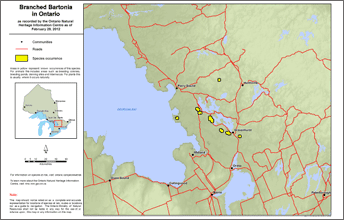Branched Bartonia
Scientific name: Bartonia paniculata ssp. paniculata

Cover photo credit: Dr. B. Eugene Wofford
Status
Threatened
“Threatened” means the species lives in the wild in Ontario, is not endangered, but is likely to become endangered if steps are not taken to address factors threatening it.
Date added to the Species at Risk in Ontario List
The Branched Bartonia was already assessed as threatened when the Endangered Species Act took effect in 2008.
What it looks like
Branched Bartonia is a spindly flowering plant that grows 10 to 40 centimetres tall. The stem is green or purple and often angled. The leaves are alternate (each leaf arising from a different point along the stem), tiny, scale-like and easily overlooked. It produces small creamy-white four-parted flowers that form a branched cluster.
Where it lives
Branched Bartonia grows in sphagnum bog or fen wetlands dominated by sedges or low shrubs. It is usually found in areas with Tamarack and Black Spruce trees.
Where it’s been found in Ontario
Branched Bartonia is found in the United States from New England south to Florida and Texas, and west to Wisconsin. In Canada, this plant has been found only at ten sites in south-central Ontario, in Muskoka and Parry Sound districts.
View a larger version of this map (PDF)
What threatens it
The main threats to Branched Bartonia are habitat destruction by all-terrain vehicles and alteration of water levels.
Two of the sites where this plant is found are also threatened by an invasive shrub called Glossy Buckthorn.
Action we are taking
Threatened species and their general habitat are automatically protected.
Recovery strategy
A recovery strategy advises the ministry on ways to ensure healthy numbers of the species return to Ontario.
Read the executive summary and the full document (December 7, 2018).
Government response statement
A government response statement outlines the actions the government intends to take or support to help recover the species.
Read the government response statement (September 5, 2019).
Review of progress
A review of progress made toward protecting and recovering a species is required no later than the time specified in the species’ government response statement, or not later than five years after the government response statement is published if no time is specified.
Read the report on progress towards the protection and recovery of 12 species at risk, including Branched Bartonia (2024).
Habitat protection
General Habitat Protection - June 30, 2013
What you can do
Report a sighting
Report a sighting of an endangered animal or plant to the Natural Heritage Information Centre. Photographs with specific locations or mapping coordinates are always helpful.
Volunteer
Volunteer with your local nature club or provincial park to participate in surveys or stewardship work focused on species at risk.
Be a good steward
- Private land owners have a very important role to play in species recovery. If you find Branched Bartonia on your land, you may be eligible for stewardship programs that support the protection and recovery of species at risk and their habitats.
- Invasive species seriously threaten many of Ontario’s species at risk. To learn what you can do to help reduce the threat of invasive species, visit:
- Consult the Ministry of Natural Resources and Forestry for information on provincial regulations and best management practices when working around wetlands and in forests. Call toll free 1-800-667-1940.
Report illegal activity
Report any illegal activity related to species at risk to
Quick facts
- This plant’s tiny fruits are only about four millimetres long, but each fruit contains 1,000 to 1,500 seeds.
- Branched Bartonia was not discovered in Ontario until 1973.
- The Ontario population of this plant interests researchers because it is located more than 600 kilometres north of the rest of the plant’s normal range in the eastern United States. Disjunct populations have also been found in Michigan and Wisconsin.
- Photosynthesis (the process of creating its own sugar using light, water and carbon dioxide) may be inefficient in this plant due to its small leaves. It is possible that like orchids, this plant may obtain some nutrients with the help of fungus in the soil.
